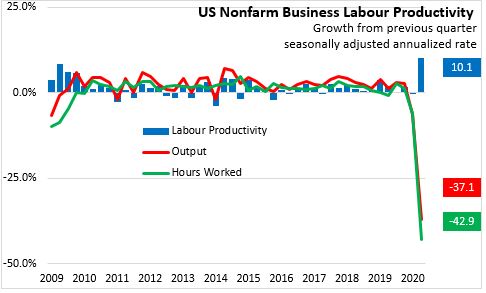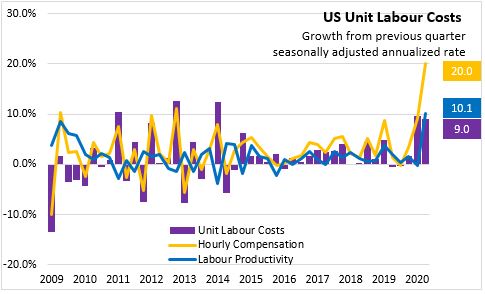The Economics and Statistics Division maintains archives of previous publications for accountability purposes, but makes no updates to keep these documents current with the latest data revisions from Statistics Canada. As a result, information in older documents may not be accurate. Please exercise caution when referring to older documents. For the latest information and historical data, please contact the individual listed to the right.
<--- Return to Archive
For additional information relating to this article, please contact:
September 03, 2020US PRODUCTIVITY, Q2 2020 The US Bureau of Labor Statistics (BLS) has released preliminary productivity estimates for the second quarter of 2020. All figures are reported as growth from the previous quarter at seasonally adjusted annualized rates.
BLS quarterly estimates of labor productivity combine output data with hours worked data based primarily on the Current Employment Statistics (CES) survey. The reference period for the CES largely predated many of the COVID-19-related job losses that occurred in the latter part of March. To capture these job losses, adjustments were made to March employment and labor productivity for the first quarter of 2020 reflect these adjustments. Given continued changes in the US economy, BLS explored the possibility of adjusting estimates again, but found that Q2 results that were similar to the usual methodology. Therefore no adjustments were made to Q2.

Nonfarm business sector labour productivity in the US increased 10.1 per cent in Q2 2020, following revised decline of 0.3 per cent in Q1. With the most severe COVID-related restrictions and closures in place output declined 37.1 per cent. However, hours worked declined at a faster pace: 42.9 per cent. This is the largest quarterly increase in productivity since 1971 while the declines in hours worked and output were the largest in records dating back to 1947.
US unit labour costs increased 9.0 per cent on a 20.0 per cent increase in hourly compensation (largest increase in data going back to 1947) which was only partially offset by the 10.1 per cent gain in productivity.

Manufacturing sector labour productivity declined 14.6 per cent in Q2 as output decreased 47.0 percent and hours worked decreased 38.0 percent. All three Q2 data points for US manufacturing were the largest declines in a data series that started in 1987. Productivity decreased 26.9 percent for durable goods in Q2 (output: -57.9 per cent; hours worked: -42.4 per cent). Productivity was down 5.1 per cent in nondurables manufacturing (output: 33.5 per cent; hours worked: -30.0 per cent). Unit labor costs across all manufacturing sectors increased 29.1 percent in Q2.
Notes: labour productivity, or output per hour, is calculated by dividing an index of real output by an index of hours worked by all persons, including employees, proprietors, and unpaid family workers. Unit labour costs are calculated as the ratio of hourly compensation to labour productivity; increases in hourly compensation increase unit labour costs while increases in productivity (output per hour) reduce unit labour costs. US manufacturing output is calculated on a different basis than for all nonfarm businesses, so these series are not directly comparable.
Source: US Bureau of Labor Statistics
<--- Return to Archive